
Sydney University Press Law Books

 |
[Home]
[Databases]
[WorldLII]
[Search]
[Feedback]
Sydney University Press Law Books |
 |
The Legal Framework for e-Research Project lead by Professor Brian Fitzgerald and hosted by the Queensland University of Technology (QUT) is funded by the Australian Commonwealth Department of Education, Employment and Workplace Relations (DEEWR), formerly Education, Science and Training (DEST), under the Systemic Infrastructure Initiative (SII), Research Information Infrastructure Framework for Australian Higher Education, as part of the Commonwealth Government’s Backing Australia’s Ability – An Innovation Action Plan for the Future (BAA).
The Project involves mapping out a sophisticated legal framework for e-Research and collaborative innovation. As we transition into the National Collaborative Research Infrastructure Strategy (NCRIS)[2] era it is vitally important that social and legal aspects of the e-Research framework are developed in step with the rapid advances in technology. Only little work has been done in this area worldwide.
This project is linking with key international actors to provide an internationally significant project. While the Open Access to Knowledge (OAK) Law Project[3] aims to examine the role of open access to all in an Internet world, this project also focuses on open innovation within secure knowledge communities – both are vital aspects of the e-Research framework. The critical issue is working out legal models for e-Research that reflect the capacity of the technologies involved and can be implemented quickly, effectively and (in many instances) in an automated way.
The Australian Federal government has implemented the National Collaborative Research Infrastructure Strategy (NCRIS) to provide greater focus and strategic direction for Australia’s research infrastructure. The NCRIS Strategic Roadmap[4] identifies priorities for investment in research infrastructure. In addition to 15 specific areas of science and technology, ‘Platforms for Collaboration’ are also designated as a priority capability area.[5] In addition to hardware and software elements, this priority area includes copyright and other legal considerations.
The conduct of research and the dissemination of its outcomes are greatly enabled by recent and continuing development in communications networks, information and computing technologies. These new technologies not only improve productivity and quality of research, they also enable entirely different kinds of research, organisational models and collaborations across every discipline, and create new research domains that could not otherwise exist.
These capabilities serve to advance and augment, rather than replace traditional research methodologies. It is important to understand the e-Research environment to ensure that any legal framework will serve to facilitate, rather than inhibit, collaborative research and innovation.
This chapter presents a brief summary of the results from a survey conducted by QUT’s Faculty of Law as part of the Legal Framework for e-Research Project.[6]
The term ‘e-Research’ encapsulates research activities that use a spectrum of advanced ICT capabilities and embraces new methodologies emerging from increased access to:
o broadband communications networks, research instruments and facilities, sensor networks and data repositories;
o software and infrastructure services that enable secure connectivity and interoperability;
o application tools that encompass discipline-specific tools, and interaction tools.[7]
The survey[8] aimed to explore the nature of research collaborations and to identify common legal and project agreement problems encountered in forming research collaborations in order to form strategies to facilitate and streamline the process of e-Research in the Australian context. Specifically, the aims of the survey were to:
o identify e-Research activities and levels of engagement;
o understand the nature of the collaborative research landscape;
o investigate characteristics of informal collaborations and agreements; and
o explore legal issues related to data and databases.
The questionnaire consisted of sections covering e-research (Section A), organisational/research areas (Section B), collaboration profiles (Section C), project agreement issues (Section D), databases (Section E) and data (Section F).
Of the 176 participants, 85 (or 48%) were in research roles, 66 (or 38%) were in research and/or organisational management and 25 (or 14%) were in legal or contracts roles. The majority of participants were from the University sector (64.8%), 9.1% from Industry/Commercial and 9.1% from Government sectors, 10.8% from other Research Institutes and 6.3% from law firms.
One-third of the sample stated that they are extensively involved with e-Research (only 10.3% stated that they are ‘not at all’ involved with e-Research). Participants were asked to describe the types of e-Research activities that their role involves. One-hundred and fifty-four participants described the kinds of activities that their e-Research involves and these were coded into broad categories based on the predominant theme of the comment. Activities described by participants included: data collection/management/modelling/visualisation and the use of databases (approximately 49% of activities); online or internet-based research (approximately 15% of activities); services to support e-Research (approximately 12% of activities); the use of communication tools (approximately 7% of activities); the dissemination of information (approximately 3% of activities); and management of e-Research activities (approximately 3% of activities).
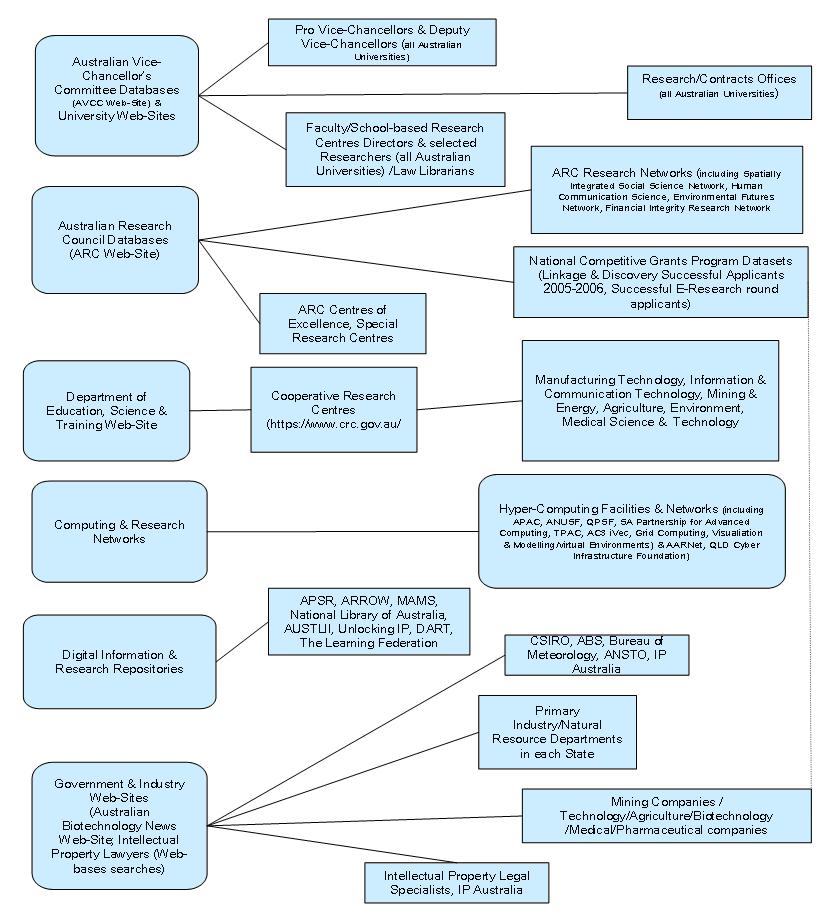
The frequency of involvement with differing parties involved in collaborative research was explored by asking respondents how frequently their collaborative projects involved industry (including commercial laboratories/R&D enterprises), universities, other research institutes, government agencies, colleagues within their organisation, clients/customers/users, suppliers and consultants (on a scale of 1 ‘never’ through to 4 ‘often’).
As expected, there is a large degree of inter-university collaboration, with universities cited as the party most frequently involved in the respondents’ collaborative projects, 81.3% stating that their projects often involve universities. Colleagues in their own organisation were also rated highly, with 72.2% of respondents identifying them as often being involved in their projects. Suppliers and consultants were the parties least likely to be involved in respondents’ collaborative research projects. Six participants nominated parties other than those listed, such as research/postgraduate students, patent/trade mark attorneys and lobbyists.
Participants were asked to specify the most important international collaborators involved in their research projects and the results are portrayed in Figure 2. Of the specified list of countries, the USA (40% identified as ‘very important’), followed by the UK (25% identified as ‘very important’) were identified as the most important countries to the participant’s collaborative projects. Of the other countries specified by participants, India, Israel, Singapore, Thailand and islands in the Pacific were the most common.

Participants were asked to rate the relative frequency (on a 4–point scale[9]) with which their collaborations involved a number of elements or arrangements, such as: informal networks (including informal conversations, conference interactions); informal agreements leading to co-authored publications; confidentiality/non-disclosure contracts; research contracts (for one project); master research contracts (involving multiple research projects); permanent research arrangements such as strategic alliances; multi-party research consortia; cooperative research centres; joint ventures and cross-licensing; patents/software (or other intellectual property licences); technical assistance agreements; and consulting agreements.
Figure 3 presents the relative frequency of responses to the 12 agreement/arrangement types for the total sample. ‘Informal networks’ (including informal conversations, conference interactions), ‘informal agreements leading to co-authored publications’ and ‘single research contracts’ were the most frequent arrangements cited. Approximately 70% of respondents stated that their collaborations often involve informal networks (including informal conversations, conference interactions), 36% stated that their collaborations often involve informal agreements leading to co-authored publications and approximately 40% stated that their collaborations often involve single project-based research contracts. Only 7% of the sample stated that their collaborations often involve joint ventures or cross-licensing (41% never) and technical assistance agreements. Approximately one-in-three participants stated that their collaborations never involve patents, software, know-how or other intellectual property licences (32.4%) or Cooperative Research Centres (30.1%). ‘Commercialisation agreements’ were mentioned as an additional type of agreement that is involved in collaborative projects.
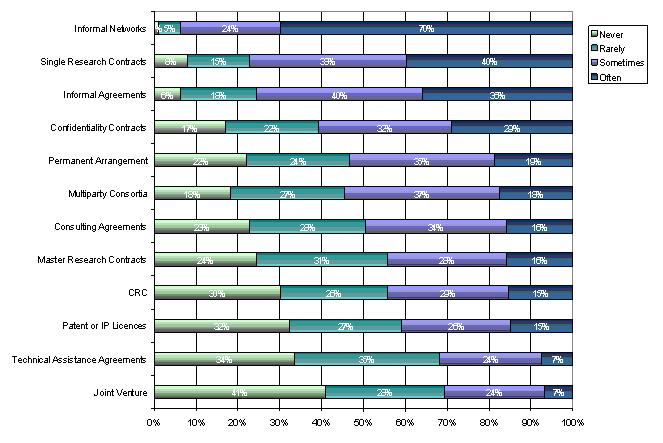
Researchers or managers (compared to those who have legal and contract roles) stated that their collaborations more often involve informal agreements leading to co-authored publications. Those who have legal and contract roles are more likely than researchers to state that their collaborations involve master research contracts or technical assistance agreements.
Managers are more likely than researchers to state that their collaborations more often involve confidentiality/non-disclosure contracts, multiparty research consortia, Cooperative Research Centres (CRC), joint ventures, patents, technical assistance or consulting agreements.
Respondents who have legal and contract roles are more likely than managers or researchers to state that their collaborations more often involve confidentiality/non-disclosure contracts, joint ventures, patents or consulting agreements.
Respondents who were from Science & Technology (compared to those from Arts & Social Sciences) stated that their collaborations more often involve master research contracts, permanent research arrangement, multiparty research consortia, or CRC.
We also wanted to gain an understanding of how informal collaborations or agreements are ‘used’. Importantly, almost half of the sample stated that informal collaborations or agreements are sometimes used for detailed disclosures, and 29.5% stating that they are sometimes used to govern a whole project.
This use of informal collaboration needs to be recognised and the advantages and disadvantages need to be fully understood. Disadvantages include uncertain payoffs (barter and exchange), information gaps, credibility gaps in the information that is disclosed, risks of misappropriation and commercialisation focus (threatens the research sharing ethos).
Participants were asked to specify the most important international collaborators involved in their research projects. Of the specified list of countries, the USA (40% identified as ‘very important’), followed by the UK (25% identified as ‘very important’) were identified as the most important countries to the participant’s collaborative projects. Of the other countries specified by participants, India, Israel, Singapore, Thailand and islands in the Pacific were the most common.
Participants were asked to rate the importance of 14 research outcomes (entering formal research agreements; patents, copyright, intellectual property; exclusive licences; non-exclusive licences; royalties, revenue, return on investment; start-up companies; co-authored publications; sharing knowledge via public disclosure or publications; sharing knowledge to limited community; student exchanges; product development, or solutions for industry/market; inflow of knowledge from industry; inflow of knowledge from researchers; better equipment, facilities; and improved research practices such as better quality, cost control, scientific evaluation) to their collaborative projects (see Figure 4).
Almost two-thirds (62%) of the sample identified co-authored publications as a very important outcome of collaborative projects (mean importance=3.44); the inflow of knowledge from researchers was identified by 60% of the sample as being very important (mean importance=3.47); and sharing knowledge via public disclosure or publications was also viewed as very important by 60% of the sample (mean importance=3.41). Figure 8 displays the mean relative importance of these research outcomes by organisational role. Three participants nominated additional outcomes such as ‘improved networking’ and ‘rewards for communicating with others’.
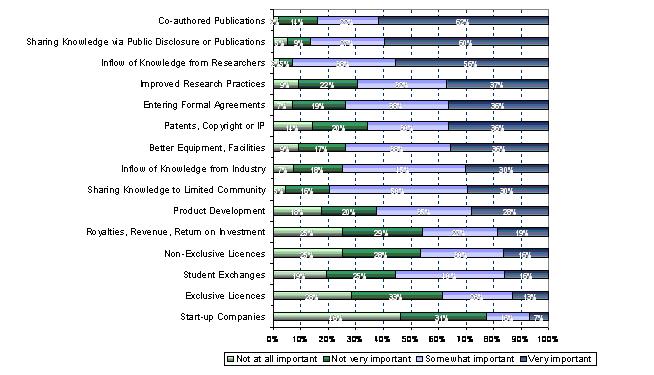
An examination of the potential differences in the importance of these collaboration outcomes by organisational role, by disciplinary area, level of involvement in e-Research and organisation sector was undertaken and Figure 5 displays the results.
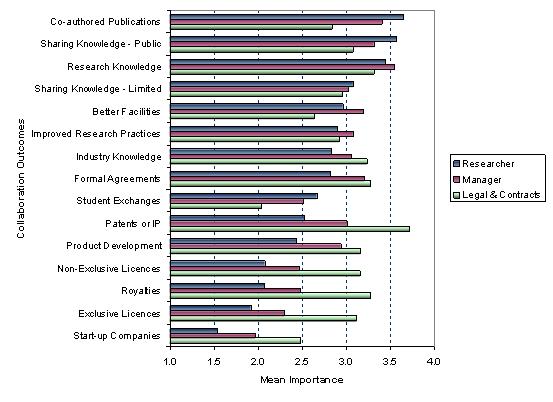
Entering formal research agreements were more important for managers than for researchers. Patents or IP, exclusive or non-exclusive licences, royalties, or start-up companies were more important for those who have legal and contract roles than for managers or researchers
Co-authored publications, sharing knowledge via public disclosure or publications or student exchanges were more important for researchers than those who have legal and contract roles. Product development was more important for those who have legal and contract roles than researchers. Co-authored publications or better equipment or facilities were more important for managers than those who have legal and contract roles.
Student exchanges and product development were more important for those who are from Science and Technology than those from the Arts & Social Sciences. Inflow of knowledge from researchers was viewed as more important by those that are moderately-extensively involved with e-Research compared to those not at all-slightly involved with e-Research.
Formal agreements, patents/IP, exclusive licences, royalties, start-up companies, product development, and inflow of knowledge from industry were viewed as more important outcomes by those in government/industry compared to those in the university sector. Co-authored publications and sharing knowledge via public disclosure or publications were viewed as more important by those in the university sector compared with those in government/industry.
Participants were asked to describe the critical factors in their most successful collaborations via an open-ended question (a total of 145 comments were received). Comments were thematically coded using the following descriptors:
o Synergies and Shared Goals &/or Resources;
o Relationships & Communication; and
o Business Planning & Practice (see Appendix B of the Survey Results for the complete list of comments).
A number of participant’s comments referred to a variety of factors, thus for coding purposes, the first factor specified was used to classify responses. Approximately half (49.0%) of comments made predominantly reflect the importance of research synergies and shared goals and resources, with approximately 40% of comments predominantly referring to the importance of good relationships and communication.
|
Comments: What do you see as the critical factors in
your most successful collaborations?
|
||
|
|
||
|
Synergies & Shared/Goals Resources (approximately
49% of comments)
|
||
|
‘For commercial research collaborations - overlapping
and complementary interests, overlapping and complementary skills, business
planning, clear and honest communication paths, expectations of ongoing
relationships and partnerships, joint negotiation of research,
precise but
flexible milestones for purely curiosity driven research - complementary and
overlapping interests and skills, clear
delineation of responsibility,
reciprocity in interaction, good communication, opportunities for formal and
informal interaction,
reasonable time frames + flexible deadlines’
(Research Centre Manager, University; Arts & Social Sciences)
‘They were all run as classic skunk works where the
altruistic came together informally with … synergistic interests and
the
shear determination to make it work.’ (Research Manager, Government; Science & Technology)
|
Relationships & Communication (approximately 40% of comments)
|
‘Knowledge of the people involved, the informality of the processes, goodwill between collaborators, reputations of the participants and recognition of the research outcomes likely to be achieved.’ (Researcher, Government, Science & Technology) |
Almost one-third of the sample believe that formal agreements are always necessary (31.1%), with approximately two-thirds stating that formal agreements are sometimes necessary (68.0%). Many comments emphasised the importance of trust in collaborative arrangements. As one participant commented: ‘If a hand shake and mutual respect won’t do it … contracts are not going to save you from each other’ (Research Manager, Research Institute; Arts & Social Sciences). Thirty-six participants commented on the necessity of formal agreements.
The average time taken to finalise formal collaborative research agreements (from initial contact) is 2.2 months for confidentiality/non-disclosure agreements (range 1–12 months); 3 months for simple two-party agreements (range 1–12 months); and 8 months for large, complex or multi-party agreements (range 1–30 months). As one participant commented: ‘Legal agreements represent the largest impediment to timely research. The writing of proposals and obtaining funds is the easiest and quickest part. Legal agreements require early involvement of lawyers’ (Researcher, University; Science & Technology).
The majority of participants felt that they have an understanding of what the terms of their formal collaborative agreements mean. There was also relatively high agreement with a statement regarding knowing about the requirements of intellectual property ownership.
A majority of the sample were satisfied with the level of input they have into formal agreements (79.7%), with only 15.3% stating that they would like more input (5.1% stated that they would like less input). For those in research roles, 22.4% stated that they would like more input into formal agreements and for research/organisational managers, 6.1% stated that they would like to have more input.
Participants were asked to identify the frequency with which a range of activities occur in the context of project agreements (see Figure 6). Almost two-thirds (62%) of the sample often consult with others such as managers and legal/contracts advisors before concluding formal agreements (5.6% never consult and 7.9% rarely consult others). Almost half of the sample stated that they often initiate discussions with other researchers for possible collaborations (44%) and 38.4% stated that they have input into the actual form of the final agreement (and 31.6% stating that they sometimes have input into the final agreement). Over half of the sample (56.5%) also stated that they never conclude formal agreements without consultation or assistance.
There were significant differences in responses by disciplinary area, whereby those in Science & Technology fields are more likely than those in Arts & Social Science fields to ‘initiate discussions with other researchers for possible collaborations’, ‘scope out collaborative projects, negotiate milestones and outcomes and ‘have input into the actual form of the final agreement’. There were also significant differences by organisational sector, whereby those from government/industry are more likely than those from the university sector to ‘assist in developing terms sheets, heads of agreement or memoranda of understanding’. Participants from universities are more likely than those from government/industry to initiate discussions with other researchers for possible collaborations.
Commencing collaborative research projects prior to the signing of agreements is a relatively common practice; with 26% stating that they ‘often’, and 54.2% stating that they ‘sometimes’, commence projects before agreements are signed (only 6.8% stated that they never start projects prior to sign-off). Comments indicate pressure surrounding timelines is often the reason for the early commencement: ‘Almost always, in fact. Generally, you've got a short-ish timeline, and you can't afford to wait months for the haggling to stop. If you don't start before the contract is signed, you'll won't finish on time and end up in violation of the terms of agreement’ (Researcher, University; Science & Technology) and ‘The legal and contractual processes can often be much slower than the time it actually takes to complete the research!’ (Contracts Officer, Research Institute; Science & Technology).
Participants were asked to share their views on the commercialisation of research. One-hundred and thirty-five participants commented on the commercialisation of research. Many of these comments reflected the view that commercialisation is an important part of the research process (approximately 30% broadly supporting commercialisation) although there can be conflicts involved. Almost one-in-four participants commented that commercialisation should play no role in research (or a limited role) or interferes with the process and/or integrity of the research.
Figure 7 depicts the relative frequency of a range of general problems potentially encountered in negotiating formal agreements. The most frequent problems encountered by participants were ‘unreasonable delays in project commencement’, ‘difficulties with government agencies’, ‘difficulties with university technology transfer offices’ and negotiation resulting in something that ‘became too complex for what the project was’. Over one-third of the sample (36%) stated that sometimes negotiation difficulties prevented the project from proceeding and that trust had been eroded.
An examination of the differences in frequencies of negotiation issues by organisational role was undertaken. Respondents who have legal and contract roles (compared to those in research roles) more often encountered the problem of the other party having all the leverage or parties having differing expectations and managers.
There were no significant differences by disciplinary area, with both those in science and technology and the arts citing unreasonable delays in project commencement as the major negotiation problem.
Participants were also asked to rate the frequency of a range of specific issues that can cause problems in negotiating formal agreements. The highest mean frequencies were attached to ‘intellectual property-ownership’, ‘data ownership and access’, ‘intellectual property-licensing’, ‘intellectual property-overvaluing it’ and ‘liability/indemnity clauses’. Half of the sample (53.1%) identified that these problems can also be a problem during the performance of the agreement.
The majority of the sample (78%) stated that when negotiating agreements they are generally able to resolve the issue of publication or public release of results (eg by a limited delay in release to allow preservation of intellectual property rights) to their reasonable satisfaction (9% stated that it was resolved but that the delay had a serious adverse effect on their publication and 6% stated that it was resolved but there was a complete embargo on some information).
The majority of the sample had not used mediation/arbitration or court proceedings. Over half of the sample strongly agreed (16.9%) or agreed (45.2%) with the statement: ‘I rely on trust to resolve disputes rather than my formal agreement’. Approximately half of the sample strongly agreed (8.5%) or agreed (45.2%) that they rely on the terms of their formal agreements to resolve disputes.
Participants were asked to rate their level of agreement with 12 statements regarding ways to improve the negotiation process (see Figure 8). The highest levels of agreement were: ‘Communication, making an express effort to understand the other party’s culture, objectives, drivers and mission’, followed by ‘Parties have had prior dealings together’ and then ‘Each party’s organisation has a clear intellectual property policy that balances issues of access, cost recovery and return on investment. ‘A generally accepted working rule that intellectual property generated in collaborative research should be divided according to relative inputs, measured by demonstrable relevance to the generated property’ was rated next important then ‘A triage approach, sorting agreements into those that need significant negotiation and those that do not’.
The lowest level of agreement was with the statement: ‘Creating a new government agency to develop and maintain a master database of standard clauses for research contracts, issue guidelines and oversee licensing practices’.
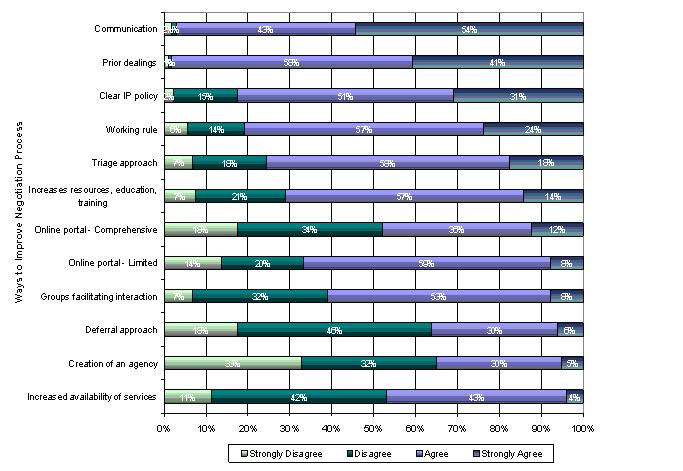
Managers were more likely to agree than researchers that communication or increased resources, education/training for transfer offices will improve the negotiation process. Managers and researchers were more likely to agree than those who have legal and contract roles that a ‘working rule’ will improve the negotiation process. Respondents who have legal and contract roles are more likely to agree than researchers that increased availability of services or increased resources/education/training for transfer offices will improve the negotiation process.
Those who are from Science & Technology are more likely to agree than those from Arts & Social Sciences that a ‘working rule’ will improve the negotiation process. Those who are moderately-extensively involved with e-Research are more likely to agree than those that are not at all-slightly involved with e-Research that ‘increased availability of services similar to contracts/technology transfer offices on a fee-for-service basis’ will improve the negotiation process.
To explore views on ways to streamline documentation processes, participants were asked to rate their level of agreement with a range of statements (see Figure 7). The statement that drew the highest level of agreement was: ‘Master agreements that allow descriptions of new projects to simply be ‘tacked on’ are useful’. There were also high levels of agreement with the following: ‘Using simple confidentiality agreements allows disclosures to occur quickly’, ‘Standard agreements would be customised anyway’ and ‘Agreements generated by assembling standard clauses would be customised anyway’. The highest levels of disagreement were attached to the statements: ‘Standard agreements for different collaborations would be widely used’; ‘A database of standard clauses for assembly into formal agreements would be widely used’; and ‘Licensing based on the ‘free/open source software’ model (e.g. free access but limitations can be imposed on use, re-use, dissemination, commercialisation of content) would be widely used’. There were no significant differences by organisational role, disciplinary area or level of involvement in e-Research.
Participants were asked to rate the importance of a range of contracting issues in the context of an increase in the practice of e-Research (see Figure 9). ‘Intellectual property (e.g. patents, copyright)’ (53% stating that it will be ‘very important’ and 38% stating that it will be ‘somewhat important’) and ‘Data ownership or access’ (51% stating that it will be ‘very important’ and 42% stating that it will be ‘somewhat important’) were the issues that participants felt would become most important with the increase of e-Research. This was followed by ‘Ease and speed of entering formal agreements’ (42% stating that it will be ‘very important’ and 50% stating that it will be ‘somewhat important’) and ‘Flexibility of formal agreements’ (43% stating that it will be ‘very important’ and 48% stating that it will be ‘somewhat important’).
‘Competition/anti-trust issues around research structures’ was seen as the least important issue in the context of increasing e-Research activities. The only significant difference between responses by organisational role was in the view of the future importance of ‘Liability’ whereby those who have legal and contract roles perceive that the issue of liability will become more important with the increase of e-Research than those in researcher roles.
A total of 95 participants completed the database section of the survey (participants who selected the organisational roles of researcher and research manager). Just over three-quarters are located in universities, with one-quarter of the sample in government or industry. Approximately 37% of the 95 participants stated that they are extensively involved in e-Research (34% moderately involved; 20% slightly involved and 9% not at all involved), with 63% identifying science and technology fields and 37% identifying arts and social science fields as their area research.
Almost half (43.2%) of the sample access external databases in conjunction with their research activities on a daily basis, 36.8% on a weekly basis and 11.6% on a monthly basis. Approximately 20% are required to register for all the databases they access, whilst 22% are required to register for more than half of the databases they access, with only 20% stating that they are not required to register to access databases.
Awareness of, and compliance with, legal restrictions associated with copying, extracting or re-using information from the databases accessed was relatively high, with 74.8% stating that they have an awareness of these restrictions and 79.0% stating that they always comply with restrictive notices presented on databases. Almost half of the databases accessed are located in Australia (47%), with over one-third located in the United States (34%).
Almost three-quarters (70.5%) of the sample felt that clearer explanations of what can be legally copied, extracted or re-used from particular databases would help facilitate their research. Fifty participants (or 52.6% of the sample) produce data or datasets that are deposited into a database. Of these participants, two-thirds (66%) created the database themselves (or their organisation created the database), and the remainder deposit into a database created by another body or institution. In terms of the location of this database, 30% are located outside of Australia. The majority of data generated is made available for access and use by other researchers (88% stating this is the case).
For those that deposit data or datasets into a database, 46% stated that it is on the basis of ‘open access’, whereby data is freely accessible with no restrictions on the use that can be made of it; 38% stated that it is on the basis of restricted access (such as to specific individuals or groups); and 8% stated that it is on the basis that it is subject to restrictions on the uses that can be made of the data (see Figure 10).
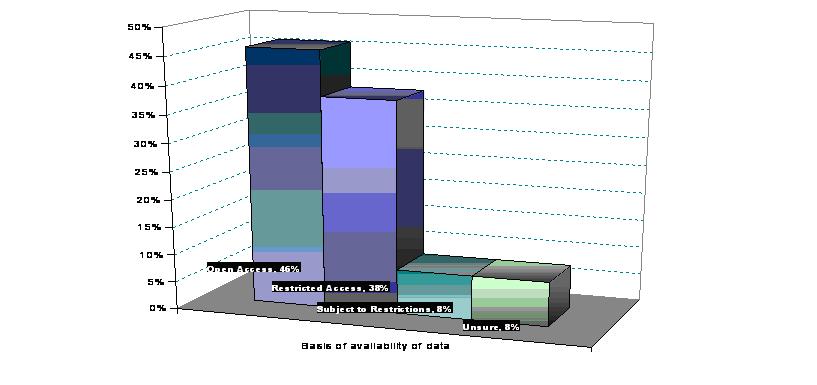
Many of the participants stated that their organisation does not have a policy setting out the basis on which research data should be deposited into databases for access by other researchers (53.7% stating that their organisation does not have a policy). Table 1 presents information related to organisational policies by disciplinary area, extent of involvement in e-Research, and organisational sector.
|
Does your organisation have a policy setting out the
basis on which research data should be deposited into databases for access by
other researchers?
|
|
|
|
Yes
%
|
No
%
|
|
|
Organisational Sector:
University
Other
|
45%
50%
|
55%
50%
|
|
Disciplinary Area:
Science & Technology
Arts & Social Sciences
|
44%
51%
|
56%
49%
|
|
Extent of Involvement in e-Research:
Not at all-Slightly
Moderately-Extensively
|
36%
51%
|
64%
49%
|
For those participants whose organisation possesses a policy regarding the depositing of data for access by others, 84.1% stated that researchers are provided with guidelines on how the policy is to be applied in practice. Just over half (55.2%) of the 95 participants stated that they (or their organisation) prepare plans for the management and/or sharing of research data, with 62.3% of these participants stating that these plans are prepared at or around the time that grant applications for project funding are prepared. Approximately 38% stated that plans are prepared later (such as ‘during the project sometime - after analysis’ or ‘once the value of the data has been identified’).
Overwhelmingly participants felt that it would assist them to have access to a ‘plain’ English ‘how-to-guide’ explaining the legal restrictions associated with databases (89.6% stating this would assist). Of those that stated that a how-to-guide would not be of assistance, the following comments indicate potential reasons: ‘ … because they are already provided by the databases’; ‘most databases I use have no restrictions’; it ‘is likely to be a large document’; ‘I don't have time to read yet more documentation written in general terms that wouldn't tell me what I needed to know about my specific situation’ and ‘it is the responsibility of the research office’.
A number of participants chose to comment on the utility of a how-to-guide: ‘This may well be useful in a day-to-day sense but it would also be interesting from a digital scholarly practice perspective to see how the legal restrictions and or guidelines actually assist or impinge on scholarly practice’ (Researcher, University; Arts & Social Sciences); ‘Lately we've been trying to apply creative commons licences in some cases, the availability of this licence has helped in some negotiations about data access’ (Researcher, University; Arts & Social Sciences); ‘A fascinating question, given that Australia is one of the very few jurisdictions relying on copyright as the relevant property right for databases (Europe has the database right, the US does not recognise property rights in data)’ (Research Manager, University; Arts & Social Sciences).
A total of 95 participants completed the data section of the survey. Almost all of the 95 participants use or generate alphanumeric data (97%), 63% use or generate images such as photographs, diagrams, graphs and/or video and 6% use or generate audio/sound data.
Overall, 26% strongly agreed and 63.5% agreed with the statement ‘I have a clear understanding of who owns the data I use in my research projects’ (10.4% disagreed or strongly disagreed). In terms of understandings of ownership of data generated, 33.3% strongly agreed and 50.0% agreed that ‘I have a clear understanding of who owns the data generated in my research projects’. For those in Science & Technology fields, 39% strongly agreed and 44% agreed with this statement. In the Arts & Humanities fields, 26% strongly agreed and 60% agreed with this statement.
The majority of the sample takes steps to ensure research data is available in a form which can be readily stored and accessed (81.2%) and 56.3% stated that their organisation currently has defined mechanisms to assist in the storing and accessing of data in the long term. Comments suggest that the storage, preservation and accessing of material in the longer term can be a challenge for organisations: ‘Though this is problematic … as there does not exist the underlying infrastructure to manage this data beyond the life of the projects’ and ‘Maintaining the data over the long term can be difficult as versions of software change’.
Almost half of the 95 respondents (47 individuals or 49%) had reservations about people outside of their projects or organisation having access to their data. To explore potential reasons for these reservations, participants were asked to rate their agreement (on a scale of strongly disagree through to strongly agree) with 9 statements. Figure 11 depicts the relative agreement related to each statement. The highest level of agreement was attached to the statements: ‘You are bound by a formal collaborative research agreement not to disclose data’ (27.7% strongly agreeing); ‘Your projects seek to commercialise the outcomes and you do not wish to compromise this’, ‘You do not want to give away your ideas’ and ‘You do not want your data to be used in research that you oppose or personally disagree with’ (12.8% strongly agreeing and 46.8% agreeing).
Managers had more reservations than researchers about people outside the project or organisation having access to data because they are bound by a formal collaborative research agreement not to disclose data and reservations about not compromising the commercialisation of outcomes. Those who are from Science & Technology fields have greater reservations than those from the Arts & Social Sciences about people outside the project or organisation having access to data because the project seeks to commercialise the outcomes. Assessment of the results explored the differences in reservations by disciplinary area, organisational sector and extent of involvement in e-Research. Participants in the university sector were also less likely to agree with the statement ‘Your projects seek to commercialise the outcomes and you not wish to compromise this’ than participants from government and industry.
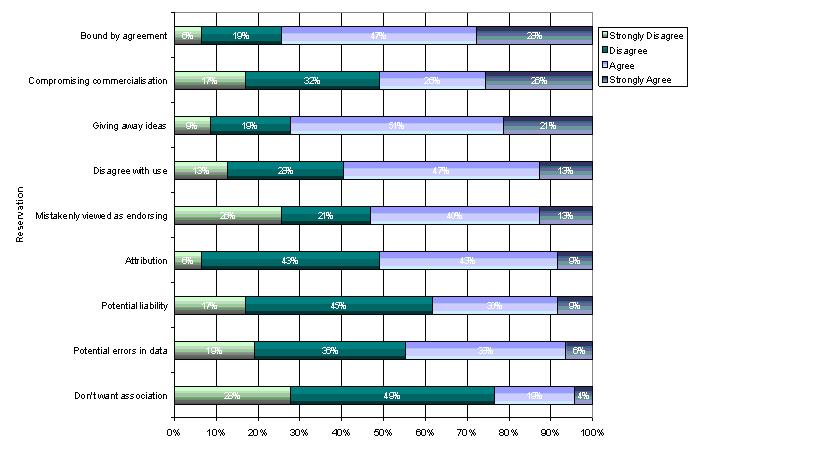
Almost three-quarters (74.5%) of those respondents who had concerns about people outside their project or organisation having access to data created as a result of the research project stated that their concerns would be reduced by having a legally binding agreement that clearly defined legal ownership and limited liability for the recipient’s use of the data. For those that felt that such an agreement would not reduce their concerns, the following comments indicate potential reasons for this perception: ‘No confidence in the law binding such people’; ‘Because ownership and liability aren't problems: ethics are’; ‘The issues of control over the use of data would not be dealt with by this’ and ‘Too difficult to obtain adherence’.
The major legal issues pertaining to establishing successful e-Research collaborations can already be broadly identified. Many of these issues are similar to those encountered in collaborative research programs using more traditional collaboration modes. However, the e-Research legal framework is potentially more complex. Collaborations by e-Research will add further complexities, which need to be identified and understood to facilitate optimisation of returns to the research participants, funding agencies and to society in general. The key points that will impact on what legal framework for e-Research will emerge include:
1. international collaboration;
2. intellectual property and data ownership;
3. the need to reduce the friction that arises in negotiations and contracting; and
4. the recognition that informality is a key ingredient and the need for the law to accommodate and promote this dynamic elements.
To achieve its overall goals the Legal Framework for e-Research Project will:
1. acquire information on e-Research collaboration through many resources including this survey;
2. consider the institutional arrangements needed for best practice e-Research contracting/team building; and
3. present legal models for e-Research that reflect the capacity of the technologies involved and can be implemented quickly, effectively and (in many instances) in an automated way.
The survey provides a valuable insight into the Australian collaborative e-Research community. If access to knowledge is a key driver enhancing social, cultural and economic development, any legal framework proposed should advance, not hinder, such sharing. Accordingly, the Legal Framework for e-Research Project will endeavour to integrate the findings of the survey into further investigations and considerations of the appropriate legal framework for e-Research. This might include:
1. development of a dynamic collaborative e-Research agreement system along the lines of that described by Professor Mark Perry, during the Legal Framework for e-Research Conference;[10]
2. development of a database of key intellectual property terms that can be considered by those who are seeking to draft the appropriate collaborative e-Research agreement;
3. development of guidelines for Data Management Plans and a Data Management Toolkit, as suggested by Anne Fitzgerald at the Legal Framework for e-Research Conference;[11] and/or
4. a handbook to assist with the timely, efficient, effective and legally robust collaborative e-Research agreements.
In many ways, our work has only just begun. We value the input received from those who participated in the survey, participated in the Legal Framework for e-Research Conference[12] and will continue to provide guidance and support for our journey ahead.
[1] Project Officer and Project Manager, Legal Framework for e-Research Project (respectively)
This chapter is based on Maree Heffernan and Nikki David, Legal and Project Agreement Issues in Collaboration and e-Research: Survey Results (2007) <http://eprints.qut.edu.au/archive/00008865/01/8865.pdf> .
The authors wish to acknowledge the assistance of Professor Brian Fitzgerald, Dr Amanda McBratney, Dr Anne Fitzgerald and Dr John Abbot and thank them for their efforts in developing and promoting the survey document.
The authors would also like to thank the following people for their valuable contribution to the development and distribution of the survey: Nikki David, Shane Dalgleish, Amy Barker, Tanya Butkovsky, DVC Professor Tom Cochrane, Dr Terry Cutler, Professor Mary O’Kane, Margot Bell, Professor Ian W. Turner, Ruth Bridgstock, Professor Paul Roe, Michael McArdle, Kerrin Anderson, Malcolm McBratney, Dr Evonne Miller, Steve Matheson, Dr Graeme Kernich, Dale Gilbert, Ray Duplock, Michael Dean, Mike Finney, Associate Professor Gillian Hallam, Clare McLaughlin, Professor Mark Perry, Terry Bell, Ruth Bridgstock, Associate Professor Chris Collet, Dr Joe Young, Karen Barnett, Dr Vladimir Likic, Professor Bernard Pailthorpe, Professor Stuart Cunningham, Professor Zee Upton, Samantha Cobb, Gaye Middleton and Professor Amanda Spink.
Special thanks to the many people who helped us disseminate the survey and the individuals who took the time to complete the survey.
[2] Australian Government, Department of Innovation, Industry, Science and Research, National Collaborative Research Infrastructure Strategy (NCRIS) <http://www.ncris.dest.gov.au/> .
[3] OAK Law Project, Open Access to Knowledge <http://www.oaklaw.qut.edu.au> .
[4] National Collaborative Research Infrastructure Strategy (NCRIS) <http://www.dest.gov.au/sectors/research_sector/policies_issues_reviews/key_issues/ncris/> .
[5] NCRIS Strategic Roadmap: Section 5.16 Platforms for collaboration <http://www.dest.gov.au/sectors/research_sector/policies_issues_reviews/key_issues/ncris/ February 2006> .
[6] A full report on all of the survey results entitled Legal and project agreement issues in collaboration and e-Research: Survey Results is available at <http://eprints.qut.edu.au/archive/00009112/01/9112.pdf> .
[7] Department of Education (DEST), e-Research <http://www.dest.gov.au/sectors/research_sector/policies_issues_reviews/key_issues/e_research_consult/> at 27 June 2007.
[8] For details of the survey description and methodology see: Maree Heffernan and Nikki David, Legal and Project Agreement Issues in Collaboration and e-Research: Survey Results (2007) 9–13 <http://eprints.qut.edu.au/archive/00009112/01/9112.pdf> at 11 March 2008.
[9] 1=Never; 2=Rarely; 3=Sometimes; 4=Often.
[10] Mark Perry, ‘Technology, Contracting and e-Research’ (Paper presented at Legal Framework for e-Research Conference, Gold Coast, 11–12 July 2007) <http://www.e-research.law.qut.edu.au/conference> .
[11] Anne Fitzgerald, ‘Building the Infrastructure for Data Access and Reuse in Collaborative Research: an Analysis of the Legal Context’ (Paper presented at Legal Framework for e-Research Conference, Gold Coast, 11–12 July 2007)
[12] Legal Framework for e-Research Conference, Gold Coast 11–12 July 2007 <http://www.e-research.law.qut.edu.au/conference> .
AustLII:
Copyright Policy
|
Disclaimers
|
Privacy Policy
|
Feedback
URL: http://www.austlii.edu.au/au/journals/SydUPLawBk/2008/51.html